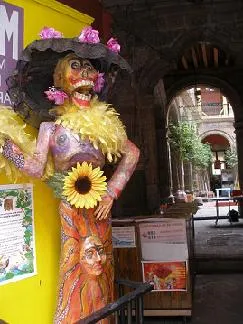Mexico and Poland are connected in more ways than we suspect, and it is because of a woman, the ill-fated Charlotte of Belgium of the House of Saxe-Coburg and Gotha, the only daughter of Leopold I of Belgium. The wife of Archduke Maximilian of Austria, the idealistic younger brother of Emperor Franz Josef of Austria, Charlotte was prized by her mother-in-law, who saw in her the perfect example of the wife to an Austrian Archduke. In that time, Maximilian was made governor of the provinces of Lombardy and Venetia, where the young couple most likely lived the happiest years of their lives despite their lack of real power, as Lombardy and Venetia were then under the rule of the Austrian Empire, and as thus, controlled by Maximilian’s older brother, Emperor Franz Josef. Both Maximilian and Charlotte were fatally eager for more challenging roles in their lives.
Then fate intervened in the form of Napoleon III, who in the early 1860s initiated the French intervention in Mexico because he wanted to turn Mexico into a satellite state of France now that it had freed itself from the yoke of the Spaniards. After months of diplomatic negotiations, Maximilian accepted the Mexican throne. Deciding to put her own court together, Charlotte sent letters to the most influential principalities in Europe. To her surprise, the majority of nobles who agreed to accompany the imperial couple in their venture to the New World were Polish.
Because Poland had been partitioned, then swallowed by Prussia, Russia, and the Austro-Hungarian Empire, these Polish nobles had their titles and their lineage but no land to call their own. Enchanted by the idea of an exotic empire in a tropical land across the ocean, they were more than eager to embark with the imperial couple to follow their dream to Mexico.
The imperial couple was crowned at the Catedral Metropolitana in 1864 and chose as their seat Mexico City. They made their home in Chapultepec castle, a neo-Gothic construction in the middle of an enormous park of precious woods, the last remains of a primeval forest surrounding the basalt crag where the castle had been built over Moctezuma’s summer palace after the conquest of Mexico by the Spaniards.
Charlotte changed her name to Carlota (Spanish for Charlotte) and gave herself to the planning of alliances between her ladies-in-waiting and the most eligible Mexican bachelors. Seduced by the beauty of the Polish women and the prospect of admittance to court, these men readily agreed to the marriages.
Polish lexicon, transliterated into Spanish, soon made its way into everyday vocabulary. This is how Mexican ladies came to cover themselves with a knitted cape known as 'chal', wear 'pantuflas' at home and 'sandalias' to step out, and go crazy over 'bizutería'. Indeed, nothing like a good 'oferta' to compel women to visit the shops or, better yet, getting something gratis. People were soon putting 'muebles' in their homes, reclining on a canapé with a 'cachorro' on their lap, and celebrating religious holidays with a 'kermés', where, together with candy, they put 'serpentinas' in the piñata.
And even though Mexicans have a love affair with death, bringing the mariachi and preparing a picnic with Mexican delicacies, sugar calaveras and pan de muerto to feast at the cemetery in honor of the dearly departed, the Day of the Dead did not become officially celebrated on 1st November until the Empire, most probably because of Polish influence.
Maximilian and Carlota’s empire, alas, was not to be as successful as the vocabulary and the traditions brought to Mexico by their Polish retinue. Only months after the coronation, Napoleon III began signaling his abandonment of Maximilian before altogether withdrawing his troops from Mexico, as he was under siege from Prussia. The withdrawal of troops was a blow to the young monarchy.
In a desperate attempt to save her husband's throne, Charlotte returned to Europe, where she begged Napoleon III not to withdraw his support. Failing to move Napoleon, she went to Vienna to plead with her brother-in-law, and from there to Rome, to try and get Pope Pius IX to intervene on her husband’s behalf. When her efforts failed, she suffered a mental collapse. She would never return to Mexico or see her husband again.
Maximilian was executed in 1867 in Querétaro, Mexico, shortly before his tenth wedding anniversary to Charlotte. It is said that his last words were 'Poor Carlota!'
Poor Carlota survived him by approximately 60 years, then died at the Bouchout Castle, in Meise, Belgium, on 19 January 1927.
The lexicon and traditions brought to court by their Polish retinue are still alive in Mexico.
Text by: América L. Martín













